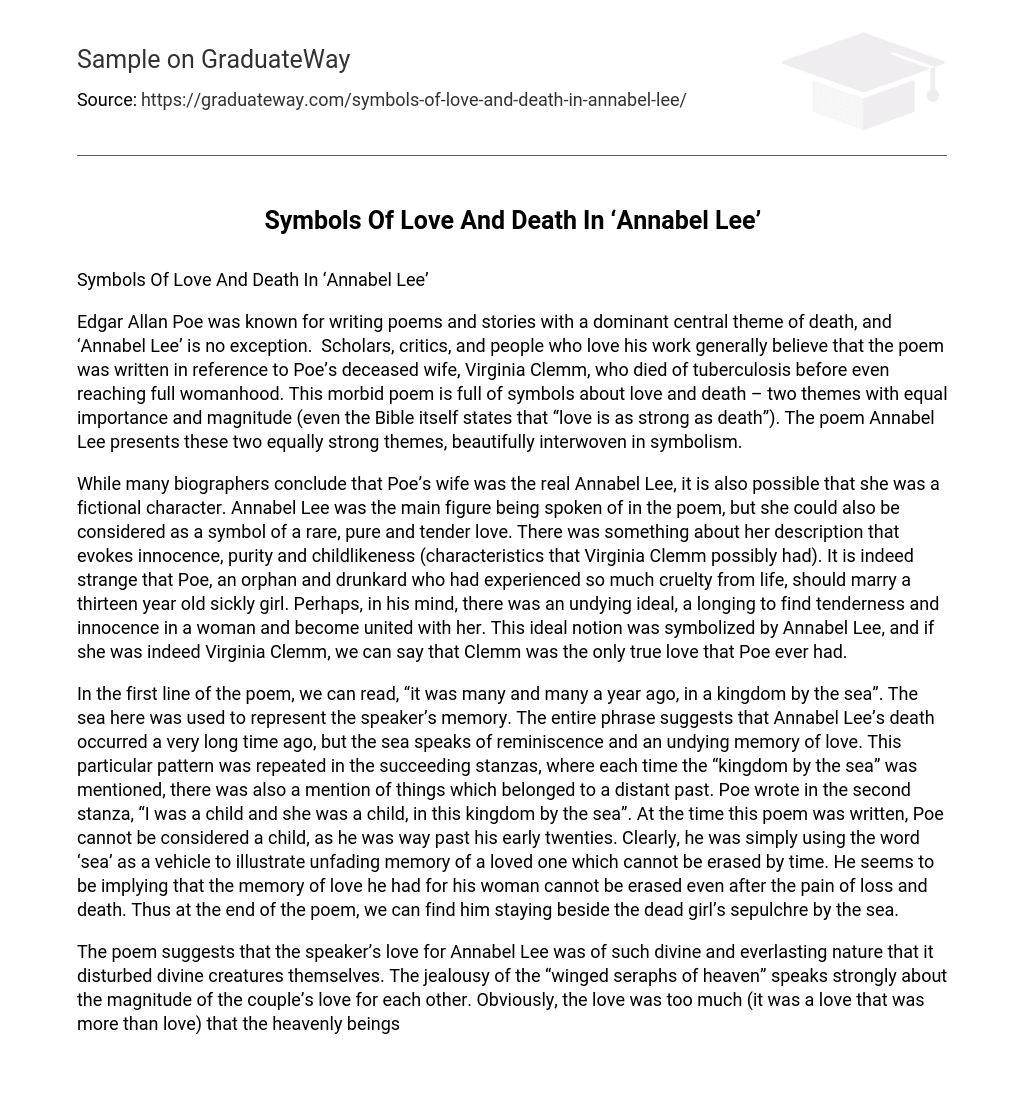Edgar Allan Poe was known for writing poems and stories with a dominant central theme of death, and ‘Annabel Lee’ is no exception. Scholars, critics, and people who love his work generally believe that the poem was written in reference to Poe’s deceased wife, Virginia Clemm, who died of tuberculosis before even reaching full womanhood. This morbid poem is full of symbols about love and death – two themes with equal importance and magnitude (even the Bible itself states that “love is as strong as death”). The poem Annabel Lee presents these two equally strong themes, beautifully interwoven in symbolism.
While many biographers conclude that Poe’s wife was the real Annabel Lee, it is also possible that she was a fictional character. Annabel Lee was the main figure being spoken of in the poem, but she could also be considered as a symbol of a rare, pure and tender love. There was something about her description that evokes innocence, purity and childlikeness (characteristics that Virginia Clemm possibly had). It is indeed strange that Poe, an orphan and drunkard who had experienced so much cruelty from life, should marry a thirteen year old sickly girl. Perhaps, in his mind, there was an undying ideal, a longing to find tenderness and innocence in a woman and become united with her. This ideal notion was symbolized by Annabel Lee, and if she was indeed Virginia Clemm, we can say that Clemm was the only true love that Poe ever had.
In the first line of the poem, we can read, “it was many and many a year ago, in a kingdom by the sea”. The sea here was used to represent the speaker’s memory. The entire phrase suggests that Annabel Lee’s death occurred a very long time ago, but the sea speaks of reminiscence and an undying memory of love. This particular pattern was repeated in the succeeding stanzas, where each time the “kingdom by the sea” was mentioned, there was also a mention of things which belonged to a distant past. Poe wrote in the second stanza, “I was a child and she was a child, in this kingdom by the sea”. At the time this poem was written, Poe cannot be considered a child, as he was way past his early twenties. Clearly, he was simply using the word ‘sea’ as a vehicle to illustrate unfading memory of a loved one which cannot be erased by time. He seems to be implying that the memory of love he had for his woman cannot be erased even after the pain of loss and death. Thus at the end of the poem, we can find him staying beside the dead girl’s sepulchre by the sea.
The poem suggests that the speaker’s love for Annabel Lee was of such divine and everlasting nature that it disturbed divine creatures themselves. The jealousy of the “winged seraphs of heaven” speaks strongly about the magnitude of the couple’s love for each other. Obviously, the love was too much (it was a love that was more than love) that the heavenly beings chose to inflict death on poor Annabel. It is possible that the “winged seraphs” personify ill fate, and the “highborn kinsman” represents God Himself. The reason for the jealousy was not explained in the poem. Either Poe merely used it as a plausible excuse to justify an untimely death, or he simply wanted to blame ill fate, or possibly God, for the loss of his love. Or perhaps, poet as he was, he was just trying to sound a little bit more poetic. We can only surmise, because only Poe, dead in his grave and his love long been buried, has all the answers to the questions that belie ‘Annabel Lee’.
Bibliography:
Bratton, Edward, K.L. Knickerbocker, Willard Reninger and B.J. Legget. Interpreting Literature. New York: CBS College Publishing, 1985.
Answers.com. “Annabel Lee (Themes)”. 10 Jun 2008 <http://www.answers.com/topic/annabel-lee-poem-3>





